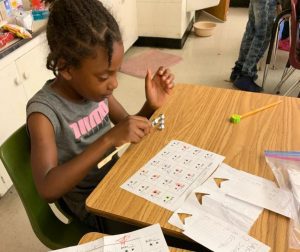Easy, On-the-Go Play Activities
Turn travel time—whether on foot or in the car—into playtime using these fun, imaginative activities!
Read More Sensory play is a simple and exciting way for children to explore their different senses, movement, balance and more in an unstructured setting. Children naturally explore textures, tastes, sounds and smells through hands-on learning, which helps to build cognitive skills. By experimenting with different materials and manipulatives, children can practice observation skills and predict and draw conclusions about the natural and physical world. Read on to learn how you can facilitate sensory play in the classroom or at home!
Sensory play is a simple and exciting way for children to explore their different senses, movement, balance and more in an unstructured setting. Children naturally explore textures, tastes, sounds and smells through hands-on learning, which helps to build cognitive skills. By experimenting with different materials and manipulatives, children can practice observation skills and predict and draw conclusions about the natural and physical world. Read on to learn how you can facilitate sensory play in the classroom or at home!
Sensory play can be facilitated in a variety of ways, and most use materials you already have on hand. These inexpensive activities can be as simple or intricate as you want and can easily be switched up based on seasons or themes in the classroom.
Sensory Bins
To create a sensory bin, take a plastic storage box and fill with age-appropriate items such as sand, uncooked rice or beans, cotton balls or feathers. Add in other small items like toys, shovels, matchbox cards, Legos, small bowls, etc. The goal is to include a variety of textures and tactile stimulation for children to experience and interact with.
For more details on creating sensory bins and for some great ideas on bin themes, check on this guide to sensory bins from the blog, Parenting Chaos.
Sensory Bags
Similar to sensory bins, sensory bags can be made for on-the-go use or to create a sensory wall. To create a sensory bag, take a plastic zip lock bag and fill with materials like shaving cream and marbles or dried pasta noodles and hair gel. If your plastic bag doesn’t have a zipper, use strong tape or double bag to ensure nothing leaks.
Check out this ‘I Spy… A Match Sensory Bag’ from PBS Kids that can be used to practice sight words, letters and numbers, or math!
Activities such as these help students explore…
Self-Awareness and Self-Management: Exploring senses through unstructured play helps children identify emotions to better manage stress, self-regulate and control their impulses. Sensory based activities can also help develop organization skills through physical and visual orientation activities.
Social Awareness: Sensory play is an opportunity for children to explore freely among their peers. Everyone interprets the world differently and it is important for children to be exposed to different perspectives and thought processes in a casual and playful way.
Be mindful of the materials you use to ensure they are age-appropriate and do not post a risk as a choking hazard. Use plastic bins that come with a lid that locks so it can be stored safely when not in use.
Double check the shelf-life of the materials you use, and be sure you switch out anything that gets icky over time.
Take your sensory bags and create a sensory! Use colorful tape to secure all four side of the sensory bag to the wall. Explore sensory play with your feet by creating a sensory play mat.
Chose a location where it’s okay to make a little mess. Outdoor sensory play is a great way to explore different materials in nature and without worry of extra cleanup!
Never force a child’s hand into a texture. Let them explore in a way that feels right for them and allow them the time they need to utilize other senses. They may need to just look or use a shovel before using their hand or even just a finger. Encourage imitation from you and slowly show them different ways they can participate.
Some children may be tactile defensive, meaning they may have a negative response to a new texture. Have towels on hand and let them know in advance that they are there if they need them to help them feel more comfortable.
For sensory play in the classroom, explore ways to carry this exploration home. Share handouts about the benefits of sensory play or ask students to journal their experience. You may also have students create their own ‘I-Spy’ sensory bag that they can take home to practice sight words or math problems.
For more activities and ideas like this one, be sure to sign up for our news and updates. And if you like what you see, please donate to support our work creating more ways to help build a healthier future for kids.
Categories: Social-Emotional Health, At Home, At School, Digital Resource